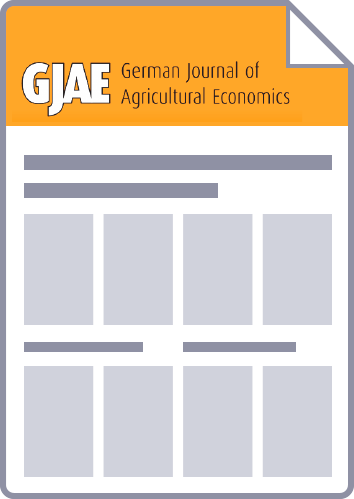Attempts to interpret performance and efficiency differences among agricultural enterprisesAttempts to interpret performance and efficiency differences among agricultural enterprises have always occupied a central position in agricultural economics. For the derivation of empirical relationships methods of statistical analysis using differentiated and preferably multivariate approaches as well as frontier functions are applied. 1. The present research activities focus on stochastic frontier models which establish a parametric cause-effect relationship between independent and dependent variables. The result of traditional LS estimates is extended in two respects. On the one hand, they include the potential to achieve a better approximation of estimated parameter values to the actual ones. On the other hand, information on the efficiency of the regarded production process is obtained owing to systematic use of the residual variance.2. In the present analysis, the possibility of gaining knowledge as involved by stochastic frontier models has been used with some restrictions. The results of the likelihood function underline that the chosen approach approximates the data better than multiple regression analysis as primary function. This statement, however, holds only true if functions of the Cobb-Douglas class are used. The studies furnished no information about the question why the potential offered by the frontier approach was not utilized by other function classes, for example linear or linear-interactive ones. 3. The frontier model is specified for each year separately and mirrors the relevant relationships of the considered highly specialized cash crop farms in a principally correct manner. Additional inputs for labour, variable operating resources and capital equipment as well as (not directly organisation-related) overheads follow the expected pattern and, depending on the business year and the production factor, reduce the net profit to a different degree.Vice versa, the net profit rises when the harvested yields and product prices go up.4. The weight of the factors that determine the success and thus the competitiveness of enterprises is quantified by use of a special algorithm for generating standardized indices. It is calculated at the beginning and at the end of a reference period, and also with regard to price and yield level. It turned out that the importance of the performance-determining factors harvested yield and product price as well as labour and (not directly organisation-related) overheads have partially notably increased in the reference period. On the other hand, however, variable cost and depreciation over time went down. A key position is occupied by the high crop yields and low cost of labour; they account for roughly 50 per cent of the potential rate of increase (nearly 500.- DM per hectare) determined under standardized conditions.5. Averaging the considered years, the mean net profit efficiency amounts to 68 per cent; it has remained almost constant. The shift in agrarian policy with the transition from high product prices without transfer payment to a system of low product prices with transfer payment, independently of company performance, has not cut the chances of enterprises to achieve differential rents as a result of outstanding managerial quality.
VOLKER PETERSEN
Published: 01.11.1999 〉 Heft 11/1999 〉 Resort: Articles
Submitted: N. A. 〉 Feedback to authors after first review: N. A. 〉 Accepted: N. A.
DOI:
N. A.
ABSTRACT
CONTACT AUTHOR

DOWNLOAD THIS ARTICLE HERE
RELATED ARTICLES
Bestimmungsfaktoren für Bodenpreise auf unterschiedlich regulierten MärktenEin Vergleich zwischen der Bundesrepublik Deutschland und Minnesota
Published: 01.06.2000
Authors: KLAUS DRESCHER, KEVIN MCNAMARA
Determinants of Farmland Prices in Different Regulated Markets – A Comparison between Germany and Minnesota This paper discusses determinants of farmland prices in Germany and Minnesota. A hedonic price model was used to estimate the implicit value of the land, agricultural structure, and regional economic attributes on farm land prices. The analysis found farmland prices…
Beurteilung der technischen Effizienz der Agrarsektoren der EU-Beitrittsländer anhand parametrischer und nicht-parametrischer Analyseverfahren
Published: 26.09.2006
Authors: Tammo Francksen, Uwe Latacz-Lohmann
This paper employs Data Envelopment Analysis and Stochastic Frontier Analysis to examine the technical efficiency of the agricultural sectors of the Central and Eastern European accession Countries (CEECs) during the period 1998-2001. The results indicate that the agricultural sectors of many accession countries are both technically inefficient and scale-inefficient. The analysis of changes in total…
Evaluierung von Agrarumweltprogrammen auf Grundlage der Umwelteffizienz landwirtschaftlicher Betriebe
Published: 08.04.2008
Authors: Tammo Francksen, Uwe Latacz-Lohmann
This paper sets out to develop an economic framework for ex post evaluations of agri-environmental schemes. We begin by developing a non-parametric model for estimating farm-level environmental efficiency scores. We then use this efficiency framework to devise a set of economic criteria for evaluating agri-environmental schemes. One key criterion is whether an environmental scheme has…


